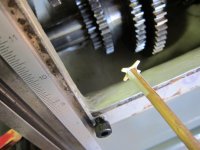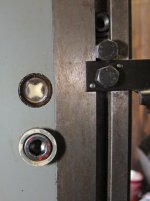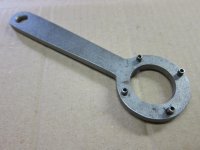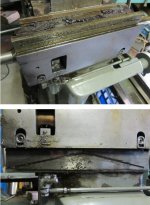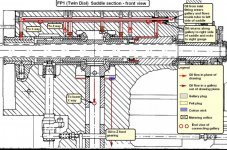Bill Fisher
Aluminum
- Joined
- Nov 17, 2013
- Location
- Sydney, Australia
Hello – my first post on this forum.
Recently I purchased a Deckel FP1 (serial no 54490/28) at auction in Melbourne. I was lucky enough to get a twin dial, SK40 version with a plastic door on the coolant pump enclosure, supplied new to Philips in Melbourne in the early 1970s, I believe. Probably was looked after immaculately by Philips, but later passed into some less careful hands.
Anyway, I decided to clean it thoroughly and pull the slides down for inspection and assessment. I quickly discovered that someone had greased the oil lube system fitted to the saddle, and thus began my current saga. The Alan “Wrench” DVD has been a great help here, and I would recommend it to any Deckel owner.
I'm sort of parallel here to ballen's great thread about his FP2 (similar age – similar problems), which revealed to me that the FP1 has some different details. A fair bit of what I have to say is covered on this forum and elsewhere (albeit scattered) so I hope to concentrate some material as well as covering some aspects I have not seen elsewhere.
Photos to follow when I work out how.
Regards,
Bill
Recently I purchased a Deckel FP1 (serial no 54490/28) at auction in Melbourne. I was lucky enough to get a twin dial, SK40 version with a plastic door on the coolant pump enclosure, supplied new to Philips in Melbourne in the early 1970s, I believe. Probably was looked after immaculately by Philips, but later passed into some less careful hands.
Anyway, I decided to clean it thoroughly and pull the slides down for inspection and assessment. I quickly discovered that someone had greased the oil lube system fitted to the saddle, and thus began my current saga. The Alan “Wrench” DVD has been a great help here, and I would recommend it to any Deckel owner.
I'm sort of parallel here to ballen's great thread about his FP2 (similar age – similar problems), which revealed to me that the FP1 has some different details. A fair bit of what I have to say is covered on this forum and elsewhere (albeit scattered) so I hope to concentrate some material as well as covering some aspects I have not seen elsewhere.
Photos to follow when I work out how.
Regards,
Bill









